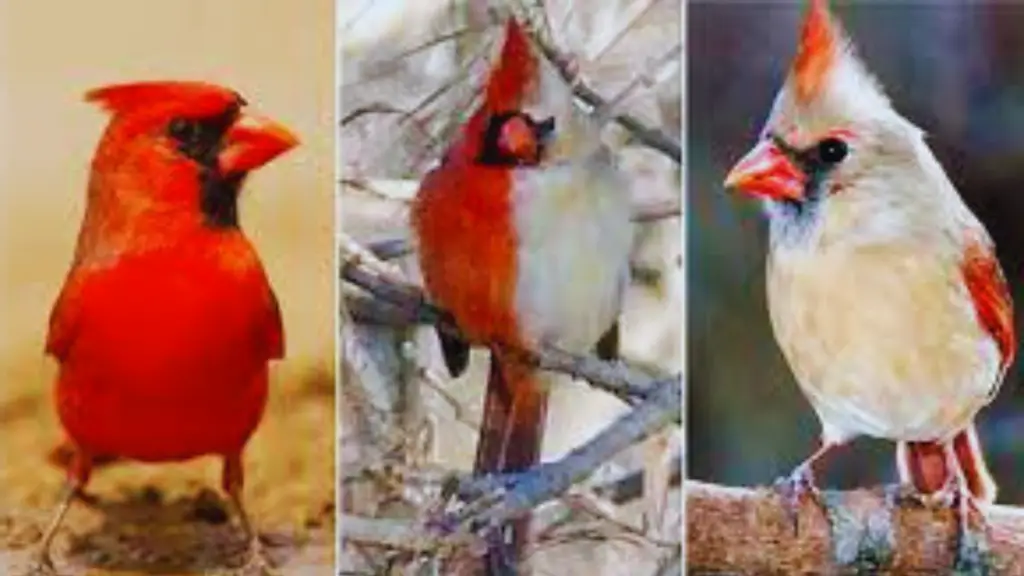What Sound Does a Cardinal Make? Discover the enchanting melodies of the cardinal, as we delve into its distinct vocalizations, from its iconic whistles to a repertoire of trills and chirps.
Imagine yourself in a serene forest with only the gentle rustling of leaves and the distant chirping of birds for company. Suddenly, a vibrant flash of red catches your eye, and you turn to see a cardinal perched on a branch. As it opens its beak, a melodic and distinctive song fills the air, captivating your senses.
Have you ever wondered what sound a cardinal makes? In this article, we will delve into the enchanting world of cardinal vocalizations. From their unique calls that serve as a form of communication to their songs that play a crucial role in courting and mating behavior, we will explore the rich musical legacy of these red songbirds.
Join us as we uncover the signature calls of cardinals and discover how they captivate our ears and hearts.
Key Takeaways
- Cardinal vocalizations include melodic songs, chirps, alarm calls, and begging calls, which serve as a form of communication within the flock and for territorial defense.
- Male cardinals have more complex and longer songs compared to females, with high-pitched whistles, trills, and warbles, while female calls are softer and simpler.
- Cardinal calls can be recognized by distinctive features such as clear whistles, rapid-fire alarms, metallic chips, and the well-known ‘cheer-cheer-cheer’ sound.
- Cardinal vocalizations have cultural significance, symbolizing love, hope, and joy in folklore, and inspiring artists and musicians.
Characteristics of Cardinals
Cardinals, with their vibrant red plumage and distinctive crest, have a melodic song that can be heard throughout their territory. These songbirds are known for their bright colors, with the males being more vibrant than the females. The male cardinal’s red plumage is a sure sign of its dominance and attractiveness. They also have a black face mask and a prominent crest on their head, adding to their striking appearance. The females, on the other hand, have a more subtle beauty with their reddish-brown feathers and a touch of red on their wings and crest.
When it comes to their song, cardinals are truly remarkable. Their melodious tunes consist of a series of clear whistles and trills. The male cardinal sings to establish his territory and attract a mate. Its song is loud and rich, with a variety of notes that create a beautiful melody. It is not uncommon to hear a cardinal singing from the treetops or even from your own backyard. Their songs are often described as sounding like ‘cheer-cheer-cheer’ or ‘birdie-birdie-birdie.’
Cardinals are not only known for their beautiful appearance but also for their enchanting songs. So, next time you hear a melodious tune echoing through the trees, chances are it’s the charming song of a cardinal, brightening up the world with its vibrant colors and signature calls.
Vocalization as a Form of Communication
Listen closely and you’ll hear the beautiful melodies, like secret messages, that the vibrant creatures of the forest share with each other. Vocalization is a primary form of communication for cardinals, allowing them to convey various messages to their flock. These red songbirds have a signature call that is easily recognizable and distinct.
In order to understand the vocalization of cardinals, it is helpful to explore the different types of calls they make. The table below provides a glimpse into the various vocalizations of cardinals:
| Call Type | Description |
|---|---|
| Song | A melodic and rich tune that is often sung by males to establish territory and attract mates. |
| Chirp | A short and high-pitched sound used for social interaction and to maintain contact with other cardinals. |
| Alarm Call | A loud and sharp call that serves as a warning to the flock when a potential threat is nearby. |
| Begging Call | A soft and repetitive call made by fledglings to request food from their parents. |
By using these different calls, cardinals are able to communicate effectively within their flock, ensuring their survival and maintaining their social structure. So, the next time you hear a cardinal’s song, take a moment to appreciate the intricate language they use to communicate with one another.
Cardinal Songs and Mating Behavior
If you want to understand cardinal songs and their mating behavior, you should know that they use their melodious tunes to attract mates.
Cardinals are also known for defending their territories through their vocalizations, warning other birds to stay away.
During courtship, male cardinals showcase their vibrant red plumage and engage in elaborate displays to woo their potential mates.
Attracting Mates
Yearning for love, you can create a symphony of enchanting melodies to captivate your potential mates. To attract a mate, the cardinal employs a variety of techniques that are sure to catch the attention of any passerby. Here are three ways you can create your own cardinal-inspired love song:
- Start with a whistling melody: Cardinals are known for their clear, high-pitched whistles. Mimic this sound by pursing your lips and blowing gently, creating a soft and inviting tone.
- Add some trills and warbles: The cardinal’s song is not complete without a mix of trills and warbles. Experiment with different pitches and rhythms, adding your own unique touch to the melody.
- Finish with a flourish: Cardinals often end their songs with a flourish, a series of quick, high-pitched notes. This adds a dramatic and captivating element to the performance.
By following these cardinal-inspired tips, you can create a captivating song that will surely entice your potential mate.
Territory Defense
To establish their boundaries, male cardinals fiercely defend their territories with a warlike symphony of fierce trills and bold melodies. They take their role as protectors seriously, using their unique vocal abilities to ward off any potential intruders.
From the highest branches of their chosen territory, they unleash a series of piercing calls that resonate through the forest. These territorial songs are not to be taken lightly, as they serve as a clear warning to other male cardinals that this area is already claimed.
With each powerful note, the male cardinal asserts his dominance and proclaims his ownership of the land. This territorial defense is crucial for ensuring that the cardinal can attract and keep a mate, as well as maintain his status within the avian community.
Courtship Displays
Now that you know how cardinals defend their territory, let’s dive into their charming courtship displays. Picture yourself in a beautiful garden, surrounded by lush greenery and the sweet scent of flowers. As you observe the vibrant red male cardinal perched on a branch, you’ll notice him puffing up his chest, tilting his head, and swaying from side to side. These intricate movements are part of his elaborate courtship routine, aimed at capturing the attention of the female cardinal. But what truly sets this display apart is the mesmerizing song that accompanies it. The male cardinal serenades his potential mate with a series of clear, whistling notes that vary in pitch and rhythm. It’s a symphony of love that echoes through the trees and fills the air with enchantment. So, sit back, relax, and let the cardinal’s courtship display captivate your senses.
| Behavior | Description | Purpose |
|---|---|---|
| Puffing up the chest | The male cardinal expands his chest, making himself appear larger and more dominant. | To impress the female cardinal and show off his physical fitness. |
| Tilting the head | The male cardinal tilts his head from side to side, displaying his agility and coordination. | To demonstrate his attentiveness and ability to care for a potential mate and offspring. |
| Swaying from side to side | The male cardinal moves his body in a gentle swaying motion, creating a graceful and mesmerizing display. | To showcase his elegance and charm, capturing the female’s attention and affection. |
| Whistling notes | The male cardinal sings a beautiful melody, consisting of clear, whistling notes that vary in pitch and rhythm. | To communicate his strength, vitality, and genetic fitness to the female cardinal. |
| Vibrant red plumage | The male cardinal’s bright red feathers are on full display, symbolizing his health, vigor, and ability to provide for a family. | To attract the female cardinal with his striking appearance and indicate his suitability as a mate. |
Cardinal Calls as Identification
If you’re wondering how to tell the difference between male and female cardinal calls, it’s all about listening closely.
Male cardinals have a clear, strong whistle, while females have a softer, more melodic call.
When you’re out in nature, keep an ear out for these distinct calls to help you identify cardinals in the wild.
And if you’re an avid birdwatcher, learning to recognize cardinal calls can be a valuable skill that enhances your birding experience.
Differentiating Male and Female Calls

Male cardinals serenade the world with their melodic calls, while the females add a touch of sweetness with their enchanting songs. Differentiating between the calls of male and female cardinals can be challenging, as they both have a wide range of vocalizations. However, there are some distinct differences to listen for. Males often have louder and more complex songs, consisting of a series of high-pitched whistles, trills, and warbles. On the other hand, females tend to have softer and simpler songs, with fewer variations in pitch and length. To help you understand the differences better, here is a table that summarizes the key characteristics of male and female cardinal calls:
| Male Cardinals | Female Cardinals |
|---|---|
| Loud | Soft |
| Complex | Simple |
| High-pitched | Lower-pitched |
| Longer | Shorter |
By paying attention to these distinctive features, you can become more skilled at identifying the gender of cardinals based on their calls.
Recognizing Cardinal Calls in Nature
Recognizing the enchanting melodies of these vibrant creatures can transport you to the heart of nature’s symphony. The cardinal’s call is unmistakable, and once you learn to recognize it, you’ll never forget it. Here are five ways to paint a picture of cardinal calls in nature:
- A bold, clear whistle that pierces through the air.
- A series of short, sharp notes that resemble a rapid-fire alarm.
- A melodic song that starts with a few slow notes and builds into a cheerful melody.
- A loud, metallic chip that echoes through the trees.
- A distinctive cheer-cheer-cheer that sounds like a happy greeting.
Whether you’re strolling through a park or enjoying the peace of your own backyard, listening for these cardinal calls will add a touch of magic to your outdoor experience.
So, keep your ears open and let the symphony of the cardinals serenade you.
Cardinal Calls in Birdwatching
Birdwatchers love listening to the distinctive melodies of cardinals, as they can identify over 15 different calls made by these beautiful songbirds. If you want to become a pro at spotting cardinals during your birdwatching adventures, it’s essential to familiarize yourself with their various calls.
One of the most common calls is the ‘peter-peter-peter’ song, which is often heard during the breeding season.
Another well-known call is the ‘whit-whit-whit’ song, which cardinals use to communicate with their mates or defend their territory.
Additionally, you may hear the ‘cheer-cheer-cheer’ call, which is frequently sung by male cardinals to establish their presence.
By learning these cardinal calls and listening for them while out in nature, you’ll be able to spot these beautiful red songbirds with ease.
Cardinal Songs in Popular Culture
In popular culture, songs of the cardinal have become synonymous with warmth and nostalgia. You can’t help but feel a sense of comfort when you hear the distinctive whistling melody of a cardinal’s song. These red songbirds have made their mark in various forms of media, from movies to music.
One of the most well-known references to cardinal songs is in the classic song ‘Red Red Robin’ performed by Al Jolson and later by artists like Doris Day. The lyrics ‘red, red robin, goes bob-bob-bobbin’ along’ capture the cheerful and lively nature of the cardinal’s call.
Cardinal songs have also made their way into movies, adding a touch of tranquility to scenes. Take the movie ‘The Notebook,’ for example. The song ‘A Bird in a Gilded Cage,’ sung by the character Allie, features the sound of cardinals in the background, creating a peaceful atmosphere that enhances the emotional impact of the scene. This use of cardinal songs in popular culture serves to evoke feelings of nostalgia, reminding us of simpler times and the beauty of nature.
Whether it’s in music or movies, cardinal songs have become a symbol of comfort and nostalgia in popular culture. Their distinct calls bring a sense of warmth and serenity, transporting us to a simpler time. So next time you hear the sweet melody of a cardinal’s song, let yourself be whisked away to a world filled with tranquility and fond memories.
Cardinal Vocalizations and Ecological Roles

Hey there, ever wondered how these little red feathered creatures bring so much harmony and balance to their ecosystems with their melodic tunes? Cardinals, with their vibrant red plumage and distinctive crests, are known for their beautiful songs that fill the air. These songs serve multiple purposes, including communication, territorial defense, and attracting mates.
Cardinal vocalizations vary depending on the situation. They have a wide repertoire of calls, including whistles, chirps, and trills. The most recognizable sound is the classic “cheer-cheer-cheer” song, often described as sounding like the bird is saying “birdie, birdie, birdie.” This song is typically sung by males during the breeding season to establish territory and attract females.
To better understand the different vocalizations and their ecological roles, let’s take a look at the table below:
| Cardinal Vocalization | Description |
|---|---|
| Whistle | Clear, high-pitched sound used for communication and to maintain contact with other cardinals. |
| Chirp | Short, sharp sound used for alarm or to signal danger. |
| Trill | Rapid, melodic sound used during courtship and to attract mates. |
Through their vocalizations, cardinals play a crucial role in maintaining the balance of their ecosystems. Their songs not only provide auditory cues for other birds but also contribute to the overall biodiversity and health of their habitats. So next time you hear the melodious tunes of a cardinal, take a moment to appreciate the important ecological role these little red songbirds play.
The Science Behind Cardinal Calls
In the Science Behind Cardinal Calls, you will explore the anatomy of cardinal vocalizations. This will provide insight into how they produce their signature calls.
Neurological and behavioral studies will shed light on the neural mechanisms behind their vocalizations and the behaviors associated with them.
Finally, learning about vocal learning and development will give you a deeper understanding of how cardinal calls evolve and develop over time.
Anatomy of Cardinal Vocalizations
The melodic trills and warbles of a cardinal’s song can transport you to a vibrant symphony of nature’s beauty. Understanding the anatomy of cardinal vocalizations can shed light on how these red songbirds produce their distinctive calls.
The key components of a cardinal’s vocal apparatus are its syrinx and vocal cords. The syrinx, located at the base of the trachea, is responsible for producing different sounds. The vocal cords, on the other hand, control the pitch and volume of the calls.
Cardinals have a wide range of vocalizations, including songs, calls, and chips, each serving a unique purpose.
- Songs: Male cardinals use melodious songs to establish territory and attract mates.
- Calls: Cardinals use various calls to communicate with their mates, offspring, and other birds.
- Chips: These short, sharp calls are often used as alarm signals to warn of potential danger.
Understanding the anatomy behind cardinal vocalizations provides insight into the complexity and beauty of their songs and calls.
Neurological and Behavioral Studies
By delving into neurological and behavioral studies, researchers have uncovered fascinating insights into the intricate processes that contribute to the mesmerizing melodies emitted by these vibrant feathered musicians.
It has been found that the cardinal’s song is produced by a specialized vocal organ called the syrinx, located at the base of the trachea. This unique structure allows for the production of a wide range of sounds, including trills, whistles, and warbles.
Additionally, studies have shown that the neural pathways involved in cardinal vocalizations are highly developed and finely tuned. The brain regions responsible for producing and controlling the cardinal’s song are highly specialized, allowing for precise control over the pitch, duration, and intensity of their vocalizations.
Furthermore, behavioral studies have revealed that cardinal songs serve multiple functions, including territorial defense, mate attraction, and communication.
Understanding the neurological and behavioral aspects of cardinal vocalizations provides a deeper appreciation for the complexities of these red songbirds’ signature calls.
Vocal Learning and Development
Now that you’ve learned about the fascinating neurological and behavioral studies on cardinals, let’s dive into their vocal learning and development.
It’s truly remarkable how these red songbirds acquire and perfect their signature calls. Cardinals are known for their ability to imitate various sounds in their environment, from other bird species to human-made noises.
As they grow and mature, young cardinals undergo a critical period of vocal learning, where they listen to adult cardinals and practice their own repertoire of songs. Through trial and error, they refine their vocalizations until they match the distinctive melodies and rhythms of their species.
This process of vocal learning and development not only helps cardinals communicate with each other but also plays a crucial role in their mating rituals and territorial defense.
It’s truly a remarkable journey of sound for these vibrant red birds.
Cardinal Calls and Seasonal Variations
Interestingly enough, the mesmerizing melodies of cardinal calls change with the seasons, surprising listeners with their unique variations. As the days grow longer and warmer, the male cardinals’ songs become more frequent and spirited, serving as a declaration of their territory and a means of attracting a mate.
Here are four seasonal variations in cardinal calls:
- Spring Serenades: In the springtime, male cardinals sing a series of rich, whistling notes that are often described as ‘cheer, cheer, cheer’ or ‘birdie, birdie, birdie.’ These songs are designed to catch the attention of females and establish their dominance among other males.
- Summertime Symphony: As summer arrives, cardinal calls take on a more complex and musical quality. Males often incorporate trills, warbles, and cascading notes into their songs, creating a symphony of sound that fills the air.
- Fall Flamenco: During the fall, cardinal calls undergo a transformation, becoming shorter and more staccato-like. The songs may resemble the rapid tapping of castanets, adding a touch of flamenco flair to the bird’s repertoire.
- Winter Whispers: In the winter months, cardinal calls become softer and more subdued. The songs are often shorter and simpler, consisting of a few clear notes that carry through the quiet winter landscape.
Throughout the year, the ever-changing melodies of cardinal calls serve as a reminder of the beauty and diversity of the avian world. So next time you hear the distinct sound of a cardinal, take a moment to appreciate the seasonal variations that make each song so unique.
Cardinal Calls Around the World

In this discussion, we’ll explore cardinal species from around the world and the unique calls they make.
You’ll learn about the cultural significance of cardinal calls in different regions and how they’ve inspired art, literature, and music.
Additionally, we’ll discuss the conservation efforts being made to protect cardinal species and their habitats.
Cardinal Species and Their Calls
Cardinal species, known for their vibrant plumage, emit a variety of distinct calls that captivate listeners. Each species has its own unique vocalization, allowing them to communicate and establish territories. The table below showcases some of the cardinal species and their signature calls:
| Cardinal Species | Signature Call |
|---|---|
| Northern Cardinal | Cheer, cheer, cheer, what, what, what |
| Pyrrhuloxia | Metallic chink |
| Vermilion Cardinal | Sweet, sweet, sweet, chew, chew, chew |
| Red-crested Cardinal | Whistle-like song |
Listening to these calls can transport you to the dense forests and open woodlands where these beautiful birds inhabit. The Northern Cardinal’s cheerful song, with its repeated notes, is perhaps the most recognizable and frequently heard. Whether it’s the metallic chink of the Pyrrhuloxia or the sweet melody of the Vermilion Cardinal, each species has its own enchanting sound that adds to the symphony of nature. So next time you hear a cardinal’s call, take a moment to appreciate the unique voice of these remarkable songbirds.
Cultural Significance of Cardinal Calls
The cultural significance of cardinal calls is absolutely mind-blowing! These vibrant red songbirds hold a special place in the hearts and minds of people around the world. Here are four reasons why their calls are so culturally significant:
- Symbolism: Cardinals have been revered as symbols of love, hope, and joy in many cultures. Their melodious songs are often associated with positive emotions and good fortune.
- Folklore: In various folklores, cardinal calls are believed to bring messages from departed loved ones or to signal upcoming events. Their distinct calls are thought to carry spiritual meanings and serve as a form of communication between worlds.
- Artistic Inspiration: Cardinal calls have inspired countless musicians, poets, and artists. Their unique melodies and harmonies have been incorporated into songs, paintings, and literature, capturing the essence of their beauty and significance.
- Sports Teams: The cardinal’s bright red plumage and powerful calls have made them popular mascots for sports teams. Their strong and confident presence is often associated with winning and competitive spirit.
The cultural significance of cardinal calls goes beyond mere sounds in nature. They hold a deep and meaningful connection to human culture, inspiring and uplifting us in countless ways.
Conservation Efforts for Cardinal Species
Take a moment to imagine the impact you could make by participating in conservation efforts for these beloved birds. Cardinals are not only beautiful to look at, but they also play an important role in our ecosystems. By protecting their habitats and ensuring their survival, we are preserving biodiversity and creating a healthier environment for all species. Here is a table highlighting some of the conservation efforts that can be done to help cardinal species:
| Conservation Efforts | Description |
|---|---|
| Habitat Protection | Preserving and restoring natural habitats, such as forests and wetlands, where cardinals thrive. |
| Reducing Pesticide Use | Minimizing the use of harmful pesticides that can affect cardinals and their food sources. |
| Nest Box Installation | Providing artificial nesting sites for cardinals, especially in areas where their natural nesting sites are scarce. |
| Public Education | Raising awareness about the importance of cardinals and their conservation needs, encouraging people to take action. |
By engaging in these efforts, you can contribute to the long-term survival of cardinal species and protect the unique beauty they bring to our world.
Recording and Appreciating Cardinal Songs
Recording and appreciating cardinal songs allows us to immerse ourselves in the enchanting melodies of these vibrant red songbirds. It’s a truly magical experience that can transport us to the heart of nature. Here are three reasons why you should take the time to listen to and record cardinal songs:
- A symphony of joy: The cardinal’s song is a celebration of life. Its rich, melodious notes fill the air with a sense of pure joy and happiness. Listening to their songs can instantly uplift your mood and bring a smile to your face.
- A connection to nature: Cardinal songs are a beautiful reminder of the natural world around us. By listening to these songs, we can feel a deep connection to the environment and appreciate the awe-inspiring beauty of the animal kingdom.
- A form of relaxation: The soothing melodies of cardinal songs have a calming effect on the mind and body. Taking the time to sit back, close your eyes, and listen to these songs can provide a much-needed escape from the stresses of daily life.
So grab your recording device and head out into the great outdoors. Find a peaceful spot, sit back, and let the enchanting melodies of cardinal songs wash over you. It’s a simple yet profound way to connect with nature and find peace in the midst of our busy lives.
Conclusion: The Musical Legacy of Cardinals
As the curtain falls on the symphony of nature, the musical legacy of these brilliant red songsters will forever echo in our hearts. Cardinals, with their melodious tunes and distinctive calls, have left an indelible mark on the world of avian music.
From their vibrant red plumage to their enchanting songs, these birds have captivated us with their unique talents.
The cardinal’s song is a mesmerizing blend of whistles, trills, and warbles. Their calls can vary in pitch and rhythm, with each bird showcasing its own unique style. Whether it’s the cheerful ‘cheer-cheer-cheer’ of the male or the softer, more subdued song of the female, the cardinal’s voice is unmistakable.
These red songbirds have not only brought joy to our ears but have also inspired artists and musicians throughout history. Their beautiful melodies have been incorporated into various musical compositions, adding a touch of nature’s magic to the world of music. From classical symphonies to modern songs, the cardinal’s song has found its place in the hearts of many.
So, as we bid farewell to the cardinal’s concert, let us remember the musical legacy they have left behind. Their songs will continue to serenade us in gardens and forests, reminding us of the beauty and wonder of nature. The cardinal’s legacy will forever be a testament to the power of music and the enduring connection between humans and the natural world.
What Sound Does A Cardinal Make? FAQs
How long do cardinals live?
Cardinals typically have a lifespan of around 10-15 years in the wild. However, some have been known to live up to 20 years. Their vibrant red feathers make them easy to spot in your backyard!
What do cardinals eat?
Cardinals, like a gourmet chef, have a diverse palate. Their diet includes seeds, berries, insects, and even fruits. They savor each bite, adding vibrant colors to nature’s grand buffet.
Do male and female cardinals look different?
Yes, male and female cardinals look different. The males have bright red feathers while the females are a more dull brown color. They also have different beak shapes and sizes.
Are cardinals territorial birds?
Yes, cardinals are territorial birds. They fiercely defend their territory from other cardinals, singing powerful songs to establish their dominance. Their bright red plumage also serves as a visual display of their territorial boundaries.
How do cardinals build their nests?
Cardinals build their nests in shrubs or trees, using twigs and grass. They weave the materials together to create a sturdy structure. The female cardinal takes the lead in nest-building while the male assists.
Conclusion
As you wrap up your exploration of cardinal songs, you can’t help but marvel at the musical legacy these red songbirds have left behind.
From the sweet trills and whistles that echo through the trees to the melodic serenades that accompany their mating rituals, cardinals have truly created a symphony in nature.
Their calls, like a chorus of passionate voices, resonate across the world, connecting us through their enchanting melodies.
So next time you hear the cardinal’s song, remember the hidden message they carry – the power of music to unite us all.














